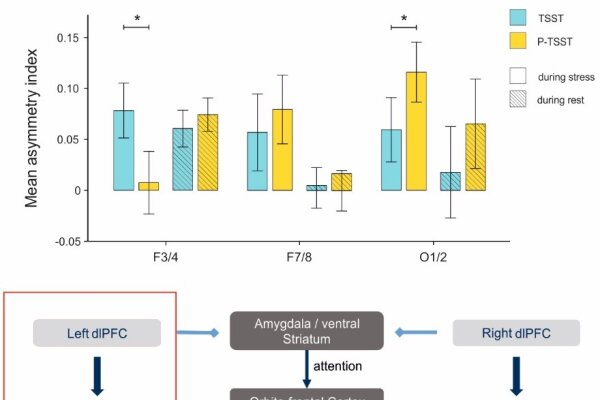2022-01-31

Each half of the brain is specialized for processing different tasks. The left hemisphere is more strongly involved in language processing while the right hemisphere is dominant for face perception.
Each half of the brain is specialized for processing different tasks. The left hemisphere is more strongly involved in language processing while the right hemisphere is dominant for face perception. For example, frontal asymmetries measured with EEG have been linked to both emotional processing in healthy individuals and affective disorders like depression. Stress provides a particularly strong source of negative emotion and has also been related to the pathogenesis of affective disorders. Hence, the aim of the present study was to investigate how acute stress affects frontal EEG asymmetries. For this purpose, continuous EEG data were acquired from 51 healthy adult participants during stress induction with the Trier Social Stress Test. In addition, EEG data were also collected during a non-stressful control condition. Furthermore, EEG resting state data were acquired after both of these conditions. In the stress condition, participants showed stronger left hemispheric activation over frontal electrode sites as well as reduced left-hemispheric activation over occipital electrode sites compared to the non-stressful control condition. There were no stress-related changes in the subsequently recorded resting state data. Our results are in line with predictions of the asymmetric inhibition model, which postulates that the left prefrontal cortex inhibits negative distractors, like the negative emotions resulting from acute stress. Moreover, the results support the capability model of emotional regulation, which states that frontal asymmetries during emotional challenge are more pronounced compared to asymmetries during rest conditions. These models suggest that left frontal activity could be indicative of stronger emotion regulation, which is more pronounced during emotional challenge.
Berretz, G., Packheiser, J., Wolf, O. T., & Ocklenburg, S. (2022). Acute stress increases left hemispheric activity measured via changes in frontal alpha asymmetries. iScience, 103841. https://doi.org/10.1016/j.isci.2022.103841

Each half of the brain is specialized for processing different tasks. The left hemisphere is more strongly involved in language processing while the right hemisphere is dominant for face perception.
Each half of the brain is specialized for processing different tasks. The left hemisphere is more strongly involved in language processing while the right hemisphere is dominant for face perception. For example, frontal asymmetries measured with EEG have been linked to both emotional processing in healthy individuals and affective disorders like depression. Stress provides a particularly strong source of negative emotion and has also been related to the pathogenesis of affective disorders. Hence, the aim of the present study was to investigate how acute stress affects frontal EEG asymmetries. For this purpose, continuous EEG data were acquired from 51 healthy adult participants during stress induction with the Trier Social Stress Test. In addition, EEG data were also collected during a non-stressful control condition. Furthermore, EEG resting state data were acquired after both of these conditions. In the stress condition, participants showed stronger left hemispheric activation over frontal electrode sites as well as reduced left-hemispheric activation over occipital electrode sites compared to the non-stressful control condition. There were no stress-related changes in the subsequently recorded resting state data. Our results are in line with predictions of the asymmetric inhibition model, which postulates that the left prefrontal cortex inhibits negative distractors, like the negative emotions resulting from acute stress. Moreover, the results support the capability model of emotional regulation, which states that frontal asymmetries during emotional challenge are more pronounced compared to asymmetries during rest conditions. These models suggest that left frontal activity could be indicative of stronger emotion regulation, which is more pronounced during emotional challenge.
Berretz, G., Packheiser, J., Wolf, O. T., & Ocklenburg, S. (2022). Acute stress increases left hemispheric activity measured via changes in frontal alpha asymmetries. iScience, 103841. https://doi.org/10.1016/j.isci.2022.103841